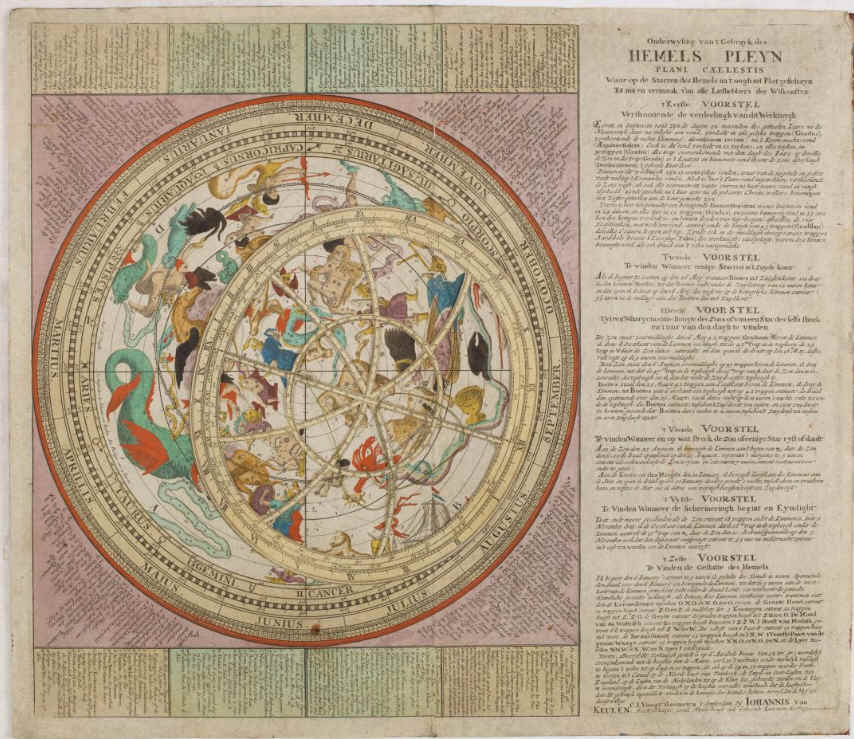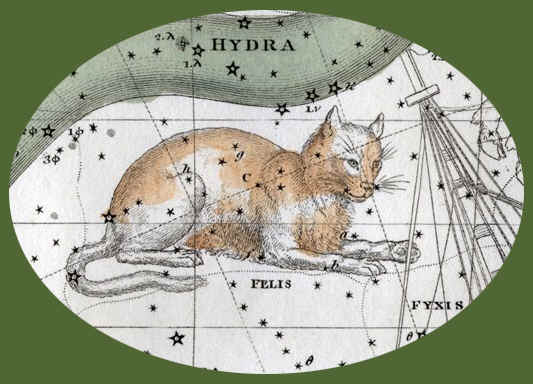
|
Claes Jansz Vooght
Jan Jansz Stampioen
|
Onderwysing van't Gebruyk des Hemels Pleyn (Plani Caelestis) Waar op de Starren des Hemels na't oogh in't Plat gestelt zijn Tot nut en vermaak van alle Liefhebbers der Wiskonsten, Amsterdam, Johannis van Keulen, c.1680-1696 Onderwys in 't Regte Gebruyk van Het Hemels - Plyn strekkende tot nut en vermaak der liefhebbers, Amsterdam 1722
|
Claes Jansz Vooght
Onderwysing van't Gebruyk des Hemels Pleyn (Plani Caelestis) Waar op de Starren des Hemels na't oogh in't Plat gestelt zijn Tot nut en vermaak van alle Liefhebbers der Wiskonsten, Amsterdam, Johannis van Keulen, c.1680-1696

La
tavola celeste che fa da fondo all’astrolabio di Vooght ha un diametro di
Pubblico
il rarissimo astrolabio
cartaceo di Vooght per cortesia di Paulus
Swaen Gallery
che lo propone in vendita:
http://www.swaen.com/item.php?id=25851
Large
engraved celestial chart (63 x
Vooght's rare star chart and astronomical calculator, here separately issued in
portfolio form and in its first state.
The chart shows the stars visible from 52 degrees latitude in a polar
equidistant projection, with a rotating volvelle or rete to indicate the part of
the sky visible at a particular moment. The circular border around the sky image
and the outer part of the volvelle include scales with several kinds of data so
that the chart can be used for various purposes. one can use the string to align
the time in the volvelle with the date in the border of the chart, so that the
part of the sky visible at that moment appears inside the volvelle. The chart
with its volvelle, scales and string can also be used to calculate times for the
rising and setting of constellations at various dates (or to calculate the
present time based on the position of the stars). Fifty-three constellations are
numbered quarter by quarter (15, 9, 14, 15), with a Dutch key identifying them
in each corner and a French and an English translation in strips of panels at
the head and foot. The instructional text, describing six "proposals"
(the first explaining the different scales, etc., and the others giving examples
of the use of the chart), stands to the right of the chart itself, and with the
text were printed together from a single plate. If the ring is turned with 12
midnight to the right, the boards can be folded to each other like a portfolio,
protecting the chart and making it easier to carry. It appears to have been
published in this form, for the copy at the Dutch Maritime Museum in Amsterdam
is similarly coloured and mounted to make a similar marbled portfolio.
The only other complete copies we have located, at the Boerhaave Museum in
Leiden and the Adler Planetarium in Chicago, and one dealer listing at Daniel
Crouch Rare Books, London are also in portfolio form.
Though designed for use at a latitude of 52 degrees, the text suggests it
remains accurate from 49 to 55 degrees, which would allow its use through much
of northern Europe.
Although astrolabes had long used a rotating off-centre ring to denote the part
of the sky visible at a given time, such a ring combined with a planispherical
star chart (like the cardboard or plastic star finders still popular today)
often is supposed to be a nineteenth-century invention. Jan Jansz. Stampioen's
1664 chart seems to be the earliest well-documented chart of this kind, though
some suppose his father's 'Coelestum Planum', mentioned in a 1619 patent and
documented in 1621, was such an instrument, and Kepler's son-in-law, Jakob
Bartsch, is also said to have made something similar. Vooght clearly based his
chart on Stampioen's 1664 edition, published by Hendrik Doncker with text by
Dirk Rembrandtsz. Van Nierop.
Neither it nor the 1684 version (also apparently published by Doncker) is known
to survive (unless the latter was the chart alone, without volvelle or
instructive text), so that Vooght's version in its present first state is the
earliest known example. Comparison with a c. 1722 edition printed from Doncker's
original plate suggests that Vooght followed Stampioen closely, with the same 53
constellations (the latest introduced by Mercator and Plancius in the sixteenth
and early seventeenth centuries) and the text in the corners describing them
copied word for word and line for line.
In 1678/79 Van Keulen (1653/54-1715) set up at the address in the present chart
(at the sign of the Crowned Pilot, opposite the new Bridge) and in 1680 he and
Vooght (c. 1637?-1696) began to publish their charts with the privilege granted
then, and re-granted to cover the years 1695 to 1710. The chart in its present
first state must date between 1680 (since it notes the fifteen-year privilege)
and 28 August 1696 (four months after Vooght's death), when Johannes Loots
described Vooght's chart as new in an advertisement for his edition, also
separately issued. his instructional text (by Simon van de Moolen, not mentioned
in the advertisement) appears on a separate slip pasted over the engraved text,
so his edition must be later than Van Keulen's. The present chart, moreover,
makes no reference to Vooght's 1696 death. The chart is also mentioned in a list
of Van Keulen publications in the 'Zee-Fakkel' (Bom, not specifying the edition),
though supposedly including Spanish text, presumably for the constellations (Bierens
de Haan probably based his description on the same advertisement). The
instructional text notes that the stars are depicted in accordance with the year
1700 ("na haar waare stand en rangh afgebeeld, zijnde geschikt na 't Jaar
1700"), but such charts were often calculated for a round-numbered year a
few years in advance. The chart later appeared in some copies of Van Keulen's
atlases, though without volvelle in the only example we have located: his
1708/09 'Zee-Atlas' (part I) at the Dutch Maritime Museum in Amsterdam (Koeman
IV, keu 28, map 6: De Vries appears to err in citing a copy in Koeman IV, keu
110B, the 1709 'Zee-Fakkel' at the Amsterdam university Library, and the Cat.
nhSM , p. 50, errs in citing a copy in a 1684 edition of the 'Zee-Atlas').
Thiele reports a copy in a 1681/1686 atlas, not now located. In numerous Van
Keulen atlases from 1682 to 1695, Koeman reports two versions of a different
celestial chart, but not this one.
Bibliografia
Bierens de Haan 5117?, Bom, Bijdragen … Van Keulen, appendix B, p. 21?, Cat.
NHSM, p. 640, E.O. van Keulen et al., "In de Gekroonde Lootsman," item
4 & illustration between pp. 64 & 65 (NHSM copy), Koeman IV, Keu 28, map
6, p. 5 & p. 370, item 272 (without volvelle), Tiele, Land- en Volkenkunde
593 note, De Vries, et al., Van Keulen Cartography, p. 207, item 240, Warner,
Sky Explored, p. 260, items 1 & 1a, Adler Planetarium on-line database
A-286, cf. V.d. Krogt, Advertenties 130 (1696 ed., pub. by Loots), not in BMC
Printed Maps, Cat. Nat. Mar. Mus., Nordenskiöld, Zinner, Astron. Instrumente,
NCC/Picarta, OCLC WorldCat.
ASTROLABIO CARTACEO















ASTROLABIO CARTACEO
I TESTI A COMMENTO














L'astrolabio cartaceo fu più volte pubblicato anche nei decenni successivi a nome
di diversi incisori: Ecco un’altra copia sempre firmata da Voogt
( per cortesia di Daniel
Crouch Rare Books di Londra che la propone in vendita):

Di seguito un altro esemplare pubblicato ad Amsterdam nel 1722 da Joachem Hasebroek con la collaborazione di
Jan Jansz Stampioen
Onderwys in 't Regte Gebruyk van Het Hemels - Plyn strekkende tot nut en vermaak der liefhebbers, Amsterdam 1722
Per cortesia di Daniel Crouch Rare Books, London


Large engraved celestial chart by
Stampioen with a rotating printed paper ring (volvelle or rete) on an off-centre
axis to indicate the part of the sky visible at any date and time and to make a
variety of celestial calculations, all for the
The
chart is here in its third state, but we have located no complete example of any
earlier version. The Boerhaave Museum in Leiden has the chart without volvelle
or instructional text, published by Doncker, but the 1664 edition described in
Doncker's advertisement clearly included the volvelle and instructional text.
Perhaps the surviving chart is the 1684 version mentioned but not seen by
Bierens de Haan, who provides neither a detailed description nor a source for
his information. They and the present version (printed from Doncker's plate c.
1722) seem to have appeared only as separate publications, hence their great
rarity. The circular border around the sky image and the outer part of the
volvelle include scales with several kinds of data so that the chart can be used
for various purposes. one can use the string to align the time in the volvelle
with the date in the border of the chart, so that the part of the sky visible at
that moment appears inside the volvelle. The chart with its volvelle, scales and
string can also be used to calculate times for the rising and setting of
constellations at various dates (or to calculate the present time based on the
position of the stars). Fifty-three constellations are numbered quarter by
quarter (15, 9, 14 and 15), with a Dutch key identifying them in each corner.
Calman's instructional text, printed letterpress on a separate slip (495 by
In the plate of the star chart itself is engraved, "Auct. J. Stampioen. 't
Amsterdam by Iochem Hasebroek" but Hasebroek's name is larger and in a
different style than the rest of the lettering, and one can see traces of an
earlier name under it. Although the older name cannot be deciphered, one can see
that "Hendrick Doncker" would fit (with traces of the h and Do, and
marks where the ascenders to the d, k and k would have been), making it clear
that the present chart is printed from Doncker's original plate. Calman
advertised his Amsterdam boarding school for calligraphy, mathematics, etc. in
1722, and Hasebroek (1682- 1756) is recorded as a sea chart publisher and
instrument maker from 1714 to 1743.
Bibliografia

























di FELICE STOPPA
DICEMBRE 2014
aggiornato
MARZO 2023
